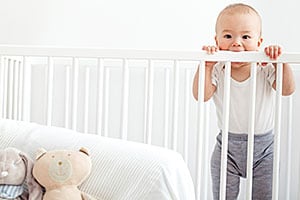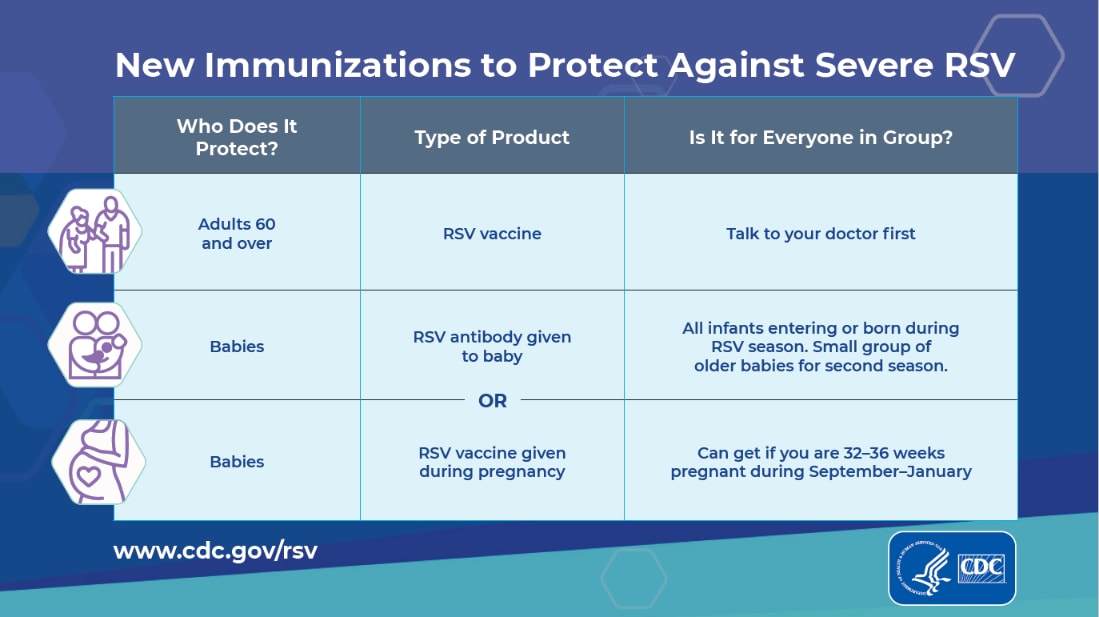RSV Prevention
How to Protect Yourself and Others
RSV immunizations are recommended only for these groups:
- Adults ages 60 and older: Two RSV vaccines (GSK Arexvy and Pfizer Abrysvo) have been licensed by FDA and recommended by CDC for adults ages 60 and older, using shared clinical decision-making.
- Pregnant women: One RSV vaccine (Pfizer Abrysvo) has been licensed and recommended during weeks 32 through 36 of pregnancy to protect infants.
- Infants and some young children: An RSV preventive antibody has been licensed and recommended for infants and some young children.
Respiratory syncytial virus (RSV) is a common respiratory virus that usually causes mild, cold-like symptoms. However, it can be dangerous for babies, toddlers, and older adults.
CDC recommends immunizations to protect those most at risk of getting very sick with RSV: infants, toddlers, and adults 60 years and older.
For others who are less likely to get a severe RSV illness, everyday preventive actions can reduce the likelihood of spreading RSV.
RSV Vaccine to Protect Adults Ages 60 and Older
A single dose of an RSV vaccine helps protect adults 60 years and older from severe RSV illness. Older adults are at greater risk than young adults for serious complications from RSV because immune systems weaken with age. Older adults who have chronic medical conditions, are elderly or frail, or are living in nursing homes are at increased risk of getting very sick from RSV and benefit the most from RSV vaccination. If you are 60 years or older, talk to your healthcare provider to see if RSV vaccination is right for you.
If you have not yet received a dose of RSV vaccine, and you decide with your healthcare provider to get one, the best time to get vaccinated is in the late summer or early fall — just before RSV usually starts to spread in the community.
For information about where to find vaccines in your area, visit Vaccine Information for Adults.

RSV Immunizations to Protect Infants and Toddlers
There are two ways to protect your baby from getting very sick with RSV. One is an RSV vaccine given during pregnancy. The other is an RSV immunization that provides antibodies to your baby after birth. If you receive RSV vaccine while pregnant, your baby will have protection and, in most cases, should not need an RSV immunization later.
The two options to protect your baby are:
- Getting an RSV vaccine if you are 32-36 weeks pregnant during RSV season. This vaccine is recommended during September through January for most of the United States because RSV is typically a fall and winter virus. The seasonality of RSV season may vary depending on where you live, and state, local, or territorial health departments may recommend different timing for administration for their area.
- Getting an RSV antibody immunization for your baby if they are younger than 8 months and born during, or entering, their first RSV season. In rare cases, a healthcare provider may determine an RSV immunization is needed for an infant even though the mother received an RSV vaccine.
A dose of RSV antibody is also recommended for children between the ages of 8 and 19 months entering their second RSV season who are in at least one of these groups:
- Children who have chronic lung disease from being born prematurely
- Children who are severely immunocompromised
- Children with cystic fibrosis who have severe disease
- American Indian and Alaska Native children
Everyday Preventive Measures to Limit the Spread of RSV
You can take everyday prevention measures to help reduce the spread of RSV and other respiratory illnesses.
- Stay home when sick.
- Cover your coughs and sneezes with a tissue or your shirt sleeve, not your hands.
- Wash your hands often with soap and water for at least 20 seconds.
- Avoid touching your face with unwashed hands.
- Avoid close contact with others, such as kissing, shaking hands, and sharing cups and eating utensils.
- Clean frequently touched surfaces such as doorknobs and mobile devices.
